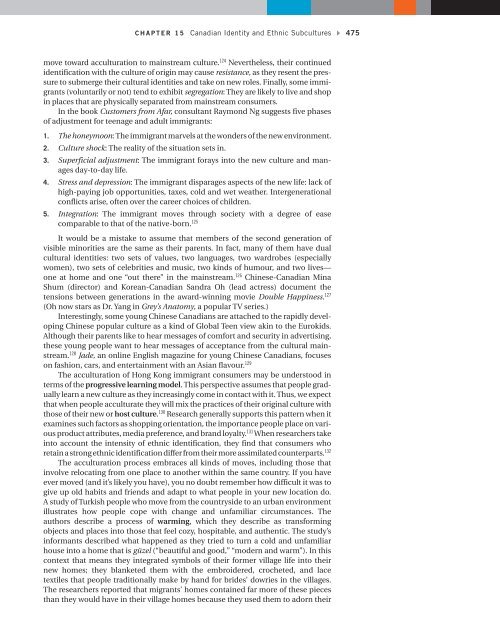Canadian Identity and Ethnic Subcultures - Pearson Canada
Canadian Identity and Ethnic Subcultures - Pearson Canada
Canadian Identity and Ethnic Subcultures - Pearson Canada
Create successful ePaper yourself
Turn your PDF publications into a flip-book with our unique Google optimized e-Paper software.
CHAPTER 15<br />
<strong>Canadian</strong> <strong>Identity</strong> <strong>and</strong> <strong>Ethnic</strong> <strong>Subcultures</strong><br />
475<br />
move toward acculturation to mainstream culture. 124 Nevertheless, their continued<br />
identification with the culture of origin may cause resistance, as they resent the pressure<br />
to submerge their cultural identities <strong>and</strong> take on new roles. Finally, some immigrants<br />
(voluntarily or not) tend to exhibit segregation: They are likely to live <strong>and</strong> shop<br />
in places that are physically separated from mainstream consumers.<br />
In the book Customers from Afar, consultant Raymond Ng suggests five phases<br />
of adjustment for teenage <strong>and</strong> adult immigrants:<br />
1. The honeymoon: The immigrant marvels at the wonders of the new environment.<br />
2. Culture shock: The reality of the situation sets in.<br />
3. Superficial adjustment: The immigrant forays into the new culture <strong>and</strong> manages<br />
day-to-day life.<br />
4. Stress <strong>and</strong> depression: The immigrant disparages aspects of the new life: lack of<br />
high-paying job opportunities, taxes, cold <strong>and</strong> wet weather. Intergenerational<br />
conflicts arise, often over the career choices of children.<br />
5. Integration: The immigrant moves through society with a degree of ease<br />
comparable to that of the native-born. 125<br />
It would be a mistake to assume that members of the second generation of<br />
visible minorities are the same as their parents. In fact, many of them have dual<br />
cultural identities: two sets of values, two languages, two wardrobes (especially<br />
women), two sets of celebrities <strong>and</strong> music, two kinds of humour, <strong>and</strong> two lives—<br />
one at home <strong>and</strong> one “out there” in the mainstream. 126 Chinese-<strong>Canadian</strong> Mina<br />
Shum (director) <strong>and</strong> Korean-<strong>Canadian</strong> S<strong>and</strong>ra Oh (lead actress) document the<br />
tensions between generations in the award-winning movie Double Happiness. 127<br />
(Oh now stars as Dr. Yang in Grey’s Anatomy, a popular TV series.)<br />
Interestingly, some young Chinese <strong>Canadian</strong>s are attached to the rapidly developing<br />
Chinese popular culture as a kind of Global Teen view akin to the Eurokids.<br />
Although their parents like to hear messages of comfort <strong>and</strong> security in advertising,<br />
these young people want to hear messages of acceptance from the cultural mainstream.<br />
128 Jade, an online English magazine for young Chinese <strong>Canadian</strong>s, focuses<br />
on fashion, cars, <strong>and</strong> entertainment with an Asian flavour. 129<br />
The acculturation of Hong Kong immigrant consumers may be understood in<br />
terms of the progressive learning model. This perspective assumes that people gradually<br />
learn a new culture as they increasingly come in contact with it. Thus, we expect<br />
that when people acculturate they will mix the practices of their original culture with<br />
those of their new or host culture. 130 Research generally supports this pattern when it<br />
examines such factors as shopping orientation, the importance people place on various<br />
product attributes, media preference, <strong>and</strong> br<strong>and</strong> loyalty. 131 When researchers take<br />
into account the intensity of ethnic identification, they find that consumers who<br />
retain a strong ethnic identification differ from their more assimilated counterparts. 132<br />
The acculturation process embraces all kinds of moves, including those that<br />
involve relocating from one place to another within the same country. If you have<br />
ever moved (<strong>and</strong> it’s likely you have), you no doubt remember how difficult it was to<br />
give up old habits <strong>and</strong> friends <strong>and</strong> adapt to what people in your new location do.<br />
A study of Turkish people who move from the countryside to an urban environment<br />
illustrates how people cope with change <strong>and</strong> unfamiliar circumstances. The<br />
authors describe a process of warming, which they describe as transforming<br />
objects <strong>and</strong> places into those that feel cozy, hospitable, <strong>and</strong> authentic. The study’s<br />
informants described what happened as they tried to turn a cold <strong>and</strong> unfamiliar<br />
house into a home that is güzel (“beautiful <strong>and</strong> good,” “modern <strong>and</strong> warm”). In this<br />
context that means they integrated symbols of their former village life into their<br />
new homes; they blanketed them with the embroidered, crocheted, <strong>and</strong> lace<br />
textiles that people traditionally make by h<strong>and</strong> for brides’ dowries in the villages.<br />
The researchers reported that migrants’ homes contained far more of these pieces<br />
than they would have in their village homes because they used them to adorn their
















